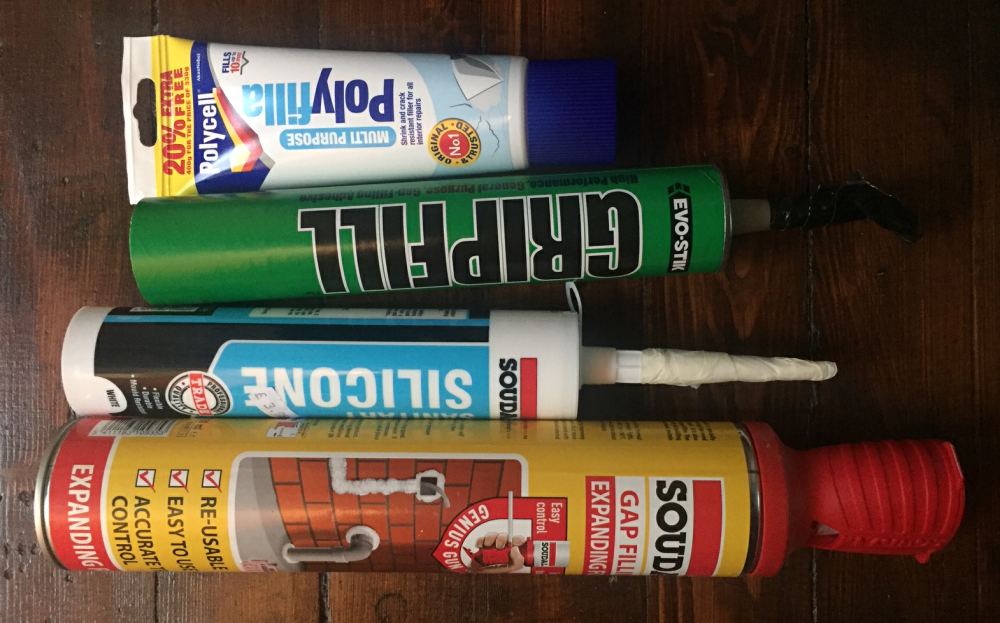Fillers for construction
In the construction industry, fillers are generally either:
- Materials that are added to other materials to modify them, making them cheaper, lighter and so on.
- Materials that create separation between other materials.
- Materials that are used to fill gaps in constructions, such as cracks, holes and joints.
Fillers for gaps have a wide range of densities, drying times, waterproofing, breathability, adhesive qualities, flexibility, colour, coarseness and so on depending on the required use.
For example, mortar can be considered a filler, as it effectively fills the gaps between bricks or stones. For more information see: Mortar.
Grout is fluid, viscous material that is used to fill and seal gaps. It is similar to mortar, but the water concentration is greater and it is less stiff which makes it more suitable for filling complex, inaccessible or small spaces. It is commonly used for tiling. For more information see: Grout.
Caulk is a commonly used filler used by decorators. It is a flexible filler typically made from acrylics or silicone, that dries quickly, but remains flexible, and so it is suitable for use where movement may be expected (such as between a plaster wall and a timber skirting). Historically caulk was made from fibrous materials that could be driven between boards, pipes and so on to make them waterproof, and rope caulks are still available. For more information see: Caulk
Silicone is a man-made polymer that is derived from silicon. It is a class of silicon-based chemical compounds that can be used to form flexible, adhesive, waterproof joints, for example around baths and showers. For more information see: Silicone.
Putty is made typically by mixing a finely ground chalk (whiting) with linseed oil. It is commonly used in traditional glazing to seal panes of glass into timber frames. Synthetic putty can be made using polybutene. For more information see: Putty.
Dry fillers are available in a powdered form, and typically consist of a powdered aggregate and an adhesive, to which water is added to the required consistency. They can generally be sanded when dry to a smooth finish and can then be painted with conventional paints.
Ready mix fillers are essentially dry fillers that have been pre-mixed so they are ready to use. They come in different degrees of stiffness, coarseness adhesion and flexibility depending on the use for which they are required. They also come in multi-purpose forms which are suitable for most common applications.
Highly-adhesive fillers are available which not only fill gaps, but also bond the items on either side of the gap, combining the properties of a filler and a glue. These are now commonly used as a substitute for nails.
Expanding foams are available for large, complex or difficult to reach gaps. They expand significantly on being discharged from a can to fill almost any size or shape or hole.
[edit] Related articles on Designing Buildings
Featured articles and news
The UK's Modern Industrial Strategy: A 10 year plan
Previous consultation criticism, current key elements and general support with some persisting reservations.
Building Safety Regulator reforms
New roles, new staff and a new fast track service pave the way for a single construction regulator.
Architectural Technologist CPDs and Communications
CIAT CPD… and how you can do it!
Cooling centres and cool spaces
Managing extreme heat in cities by directing the public to places for heat stress relief and water sources.
Winter gardens: A brief history and warm variations
Extending the season with glass in different forms and terms.
Restoring Great Yarmouth's Winter Gardens
Transforming one of the least sustainable constructions imaginable.
Construction Skills Mission Board launch sector drive
Newly formed government and industry collaboration set strategy for recruiting an additional 100,000 construction workers a year.
New Architects Code comes into effect in September 2025
ARB Architects Code of Conduct and Practice available with ongoing consultation regarding guidance.
Welsh Skills Body (Medr) launches ambitious plan
The new skills body brings together funding and regulation of tertiary education and research for the devolved nation.
Paul Gandy FCIOB announced as next CIOB President
Former Tilbury Douglas CEO takes helm.
UK Infrastructure: A 10 Year Strategy. In brief with reactions
With the National Infrastructure and Service Transformation Authority (NISTA).
Ebenezer Howard: inventor of the garden city. Book review.
The Grenfell Tower fire, eight years on
A time to pause and reflect as Dubai tower block fire reported just before anniversary.
Airtightness Topic Guide BSRIA TG 27/2025
Explaining the basics of airtightness, what it is, why it's important, when it's required and how it's carried out.
Construction contract awards hit lowest point of 2025
Plummeting for second consecutive month, intensifying concerns for housing and infrastructure goals.
Understanding Mental Health in the Built Environment 2025
Examining the state of mental health in construction, shedding light on levels of stress, anxiety and depression.






















